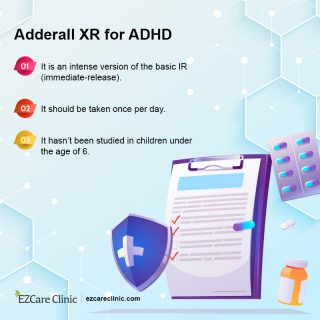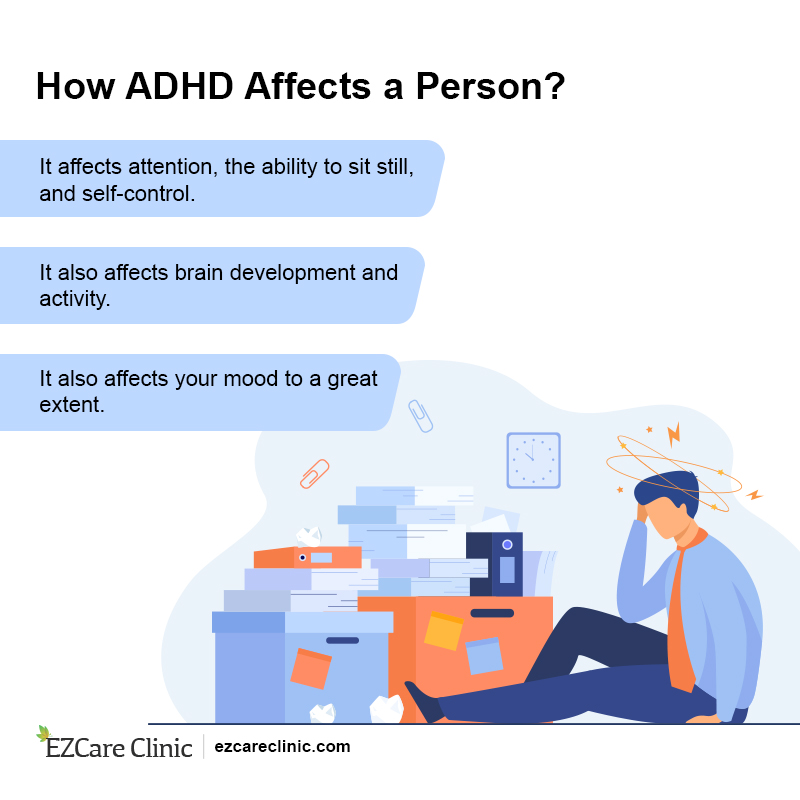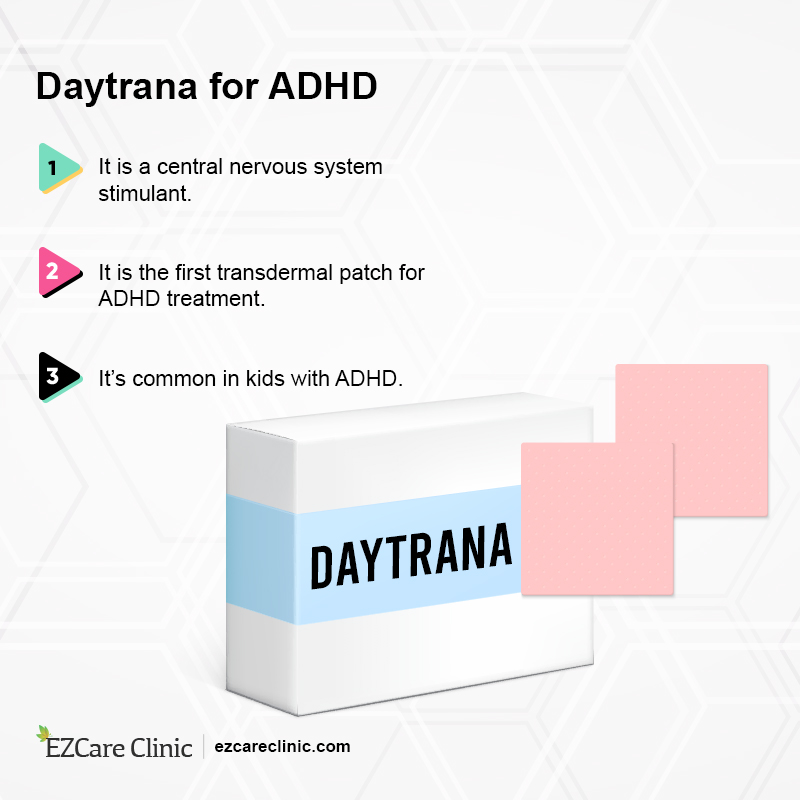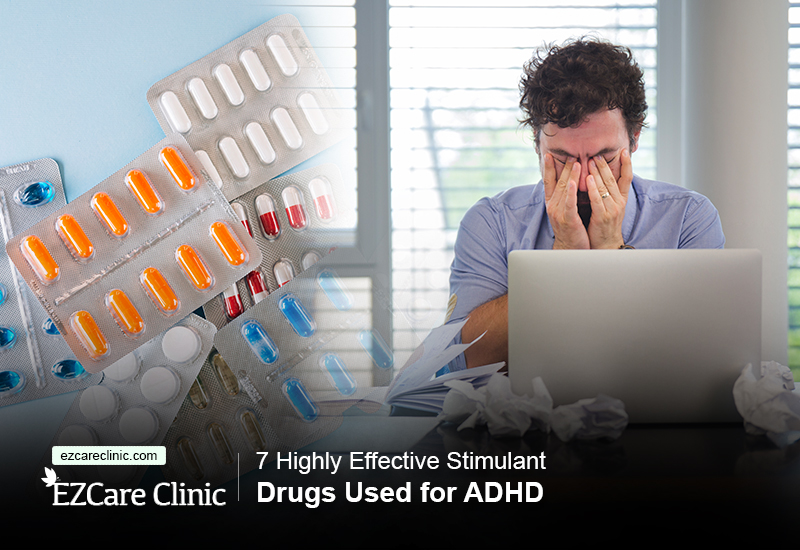If you find any of these situations familiar, there is something you need to know:



Evekeo[1]
eventually travels up to the brain, where it balances out the chemicals responsible for controlling our impulses, focus, and mental energy. When it levels things out, your brain is less likely to misfire due to too much (or too little) of one hormone.
is heavily advertised as a pediatric ADHD treatment, which means it comes in dosages safe enough for your child.

- You find it impossible to sit at your desk for longer than a few minutes
- Mental tasks are extremely draining
- You’re constantly embarrassed even though you didn’t forget to wear your pants or anything
- Anything that’s even mildly distracting is all it takes to derail your focus
- Staying still is a death sentence; you have to keep doing something at all times
- You have seven ongoing projects, none of which are even close to done
Terms Your Need to Know
- Bioavailability: the bioavailability of a drug is the degree or rate at which it is absorbed into your system. Any drug that’s administered intravenously (through a blood vessel) has 100 % bioavailability because it all goes into your blood. Drugs administered orally have to go through the harrowing journey of digestion, so they never make it unscathed.
- Interaction: drug interaction refers to how a particular drug reacts with other substances. This information is crucial when you’re getting a new prescription because it helps you avoid complications.
- CNS: The Central Nervous System, which has the receptors for most of the stimulants we will be talking about. The CNS is very delicate. In other words, drug overdoses involving the CNS never end well.
1. Adderall (C9H13N)
Adderall is a CNS stimulant that’s used to treat attention deficit hyperactivity disorder (ADHD). It goes by the street names ‘speed’, ‘uppers’, and the very eloquent ‘smart pill’. Outside of medical use, Adderall is a popular party drug as well as a powerful focus enhancer that helps unprepared college students study for their finals. Because of these unconventional applications, Adderall is a Schedule II Controlled substance, which you can’t obtain without a prescription.How It Helps
Adderall is a mixture of dextroamphetamine and amphetamine. These two compounds are stimulants. As you (may or may not) know from your grade-school science, stimulants are chemicals that trigger your brain’s reward system. When Adderall is introduced to the system, it causes the brain to produce dopamine (the ‘feel-good’ hormone), which stops an ADHD patient from feeling gloomy, restless, and self-conscious. Caution is necessary when starting an Adderall prescription because the drug can be habit-forming. Medical authorities rank it alongside the likes of cocaine (yikes) and morphine in terms of addiction level.How Good Is It?
In terms of bioavailability, Adderall is the most effective ADHD medication out there. It remains 75 % – 100 % bioavailable when administered orally. That’s one tough drug considering how powerful our digestive enzymes are. Adderall is also available in slow and quick-release capsules, which means there are doses that are small enough for kids. In its slow-release form, it is known as Adderall XR, which has a longer duration of action than the standard Adderall.Any Side Effects?
When taken for prolonged periods, Adderall may have some side effects. These are the common ones:- Dry mouth
- Headaches and dizziness
- Weight loss
- Mood changes (increased nervousness)
- Stomach pain and loss of appetite
- Insomnia
- Increased heart rate
- Chest pain, dizziness, difficulty breathing (signs of a heart problem)
- Hallucinations, paranoia, aggression, and various behavioral problems (signs of psychosis)
- Changes in skin color, numbness, damaged skin, and tissue, feeling cold (signs of a circulatory issue)

ADHD medication
What You Should Know Before Taking Adderall?
- Before scheduling an appointment, first, establish the presence of ADHD by checking for signs and symptoms.
- Book an appointment as soon as you confirm that you or your loved one show ADHD symptoms.
- Reveal your full medical history. Stimulants like Adderall have been known to cause sudden death in people with heart problems (e.g. congenital heart defect), heart disease, or a history of sudden death.
- Confirm that the person in need of medication is neither pregnant nor planning to get pregnant. Adderall can cause premature delivery, low infant birth weight, and withdrawal symptoms in the newborn.
- Confirm that the person in need of Adderall is not taking MAO inhibitors and serotonin reuptake inhibitors (SSRIs), which are common antidepressants. Also, ask your doctor whether it’s okay to take stomach acid relievers (sodium bicarbonate, Alka-Seltzer), heartburn medication, blood pressure medicine, blood thinners, and decongestants.
2. Focalin XR (C14H19N02)
Focalin XR is another mild stimulant used to treat ADHD. Like Adderall, it is also available in a quick release and an extended-release capsule, which is what goes by Focalin XR. Focalin contains dexmethylphenidate, a CNS stimulant that alters brain chemicals to enhance impulse control and reduce hyperactivity. Like Adderall, Focalin XR is a habit-forming drug that’s not ideal for people with a history of alcohol and drug abuse.How Does It Help?
How does Focalin help ADHD? Although the science is a bit complicated, Focalin XR helps to treat ADHD by preventing the reuptake of dopamine and norepinephrine, two ‘feel-good’ hormones in the brain. This action increases the production of the hormones beyond neuronal spaces, which in turn increases the presence of dopamine in the brain. Click the button below to get professional help on treating ADHD!How Good Is It?
Unlike Adderall, Focalin XR is only 11 % – 52 % bioavailable when administered orally. Nevertheless, it is still a potent CNS stimulant when issued in the right doses. It just doesn’t handle the digestive journey very well. Focalin XR metabolizes in the liver, which is the body’s center for detoxification. While the extended-release capsule is ideal for pediatric patients, adults can opt for the standard Focalin, which releases slightly larger doses over a shorter period.Any Side Effects?
The most common side effect of Focalin is anxiety. Patients exhibit higher levels of anxiety as they continue to take the medication. Other less common side effects are:- Irritability
- Fever
- Loss of concentration
- Moodiness
- Insomnia
- Fatigue
- Irregular heartbeat
- Depression
What You Should Know Before Taking Focalin XR
- The patient must exhibit signs and symptoms of ADHD even before you seek a professional diagnosis.
- Focalin XR is not for people with extreme agitation, tension, Tourette’s Syndrome, acute anxiety, and glaucoma.
- Focalin XR may cause psychosis in people with a history of depression, bipolar disorder, and other mental illnesses.
- Don’t take Focalin XR if you’ve used an MAO inhibitor such as methylene blue, tranylcypromine, linezolid, or isocarboxazid in the last 14 days.
- There is a chance that the stimulant can cause circulation problems, which may result in numbness and feeling cold. Pain and discoloration may also manifest in the fingers and toes.
3. Ritalin (C14H20CINO2)
Ritalin is the trade name of a CNS stimulant known as methylphenidate, which is a medicine used to treat ADHD. It is administered orally or topically through the use of capsules and dermal patches. Ritalin is a first-line treatment for ADHD. As much as that speaks positively for its effectiveness, it also implies the possibility of side effects that are less than pleasant. Like many stimulants, Ritalin can be addictive if abused or taken without a prescription. Ritalin and Focalin XR belong in the same family of stimulants, so their effects are more or less similar. However, Ritalin is not packaged in an extended-release capsule.How Does It Help?
Ritalin works by changing the amounts of natural brain chemicals to reduce hyperactivity and control impulses. This effect is useful for controlling behavior, increasing attentiveness, and maintaining concentration on one activity at a time. It can also improve your listening skills. You’ll be surprised how much you miss when you don’t sit still and listen, which is a tall order for anyone with ADHD. Ritalin is best taken orally about 45 minutes before mealtimes. It is advisable to take it in the first half of the day to avoid sleeping problems.
ADHD’s Effects
How Good Is It?
Ritalin has a bioavailability of between 11 % – 52 %, which means close to half of it is lost during digestion. It doesn’t survive stomach juices as well as stimulants like Adderall. Moreover, it is a CNS stimulant that doesn’t agree with any type of MAO inhibitor that’s used to manage conditions like depression. Like Focalin XR, Ritalin works by tricking the brain into releasing dopamine and norepinephrine hormones into extraneural spaces, cutting off impulsive habits, and reinforcing attentiveness.Any Side Effects?
How does Ritalin make you feel? The most common side effect of Ritalin is a quickened or irregular heartbeat. Other side effects are not very common, although prolonged use of the drug may increase your chances of experiencing them. They include:- Hives/skin rash
- Chest pain
- Joint pain
- Fever
- Blurred vision
- Flaky skin
- Muscle cramps
- Motor tics
- Seizures (convulsions)
What You Should Know Before Taking Ritalin
- Don’t take or administer Ritalin if you or the patient in question has glaucoma, Tourrette’s disease, or severe anxiety.
- Confirm that the patient exhibits signs of ADHD before administering Ritalin.
- Discuss your medical history in length with your doctor to understand the risks involved, which may include dependency, sudden death (only if you have a heart defect), and premature births.
- Don’t take Ritalin if you’re currently on antidepressants such as SSRIs and MAO inhibitors. Antidepressants and stimulants react as well as hot oil and water, so be careful not to mix them.
- Follow the exact dosage instructions issued by your doctor. That includes taking the medication when indicated and in the correct amount. This measure is there to prevent addiction as well as to ensure that the medication is working efficiently.
4. Vyvanse (C15H27N3O)
Vyvanse, which is also known as lisdexamfetamine, is not only a common ADHD treatment but also a serious contender for the most ridiculous name in the medical field. It is an FDA-approved CNS stimulant affecting the chemicals in the brain that regulate hyperactivity and impulse control. The drug is certified for use in treating ADHD in children as young as 6 years old. It can also be used on adults for ADHD as well as binge eating, a severe eating disorder that causes extreme weight gain and a host of nutritional problems.How It Helps
Like most of the drugs we’ve talked about already, Vyvanse has a noticeable impact on our brain chemistry. When ingested orally, it tinkers with the hormones in the brain to create an environment with more happy chemicals such as dopamine and norepinephrine. It also helps to regulate the chemicals that contribute to impulse control, making us capable of paying attention to a single activity for a long period.How Good Is It?
Vyvanse remains 96.4 % viable after passing through the brutal rite of passage that is digestion. If you’ve been paying attention, then you can tell that its bioavailability is far more impressive than that of Focalin XR and Ritalin. This fact also means that even small doses of Vyvanse can be quite potent, so following your prescription to the letter can be the difference between proper medication and drug abuse. The body metabolizes Vyvanse in the liver and intestines before excreting it through the kidneys (urination). That means you have to drink a lot of water when taking Vyvanse.Any Side Effects?
Vyvanse rarely causes unwanted effects. However, because we’re smart and like to stay prepared, here are some side effects to look out for: Uncontrollable vocal and motor tics (tics are sudden movements that occur randomly and usually without your knowledge)- Irritability
- Lack of appetite
- Nausea
- Agitation
- Trouble sleeping
- Fatigue
- Chest pain
- Large hives on the face, limbs, or reproductive organs
- Uncoordinated movement
- Irregular heartbeat
- Skin lesions
- Tightening of the chest
What You Should Know Before Taking Vyvanse
- Vyvanse is a stimulant that should not be taken along with antidepressants of any kind. That includes MAO inhibitors and selective serotonin reuptake inhibitors. Let your doctor know if you are currently on any such medication.
- Vyvanse has a high risk of addiction and dependency. It is important to assess the alcohol and drug dependency of the patient before putting them on Vyvanse.
- Quitting cold turkey (without warning) may cause the patient to develop withdrawal symptoms. Also, taking Vyvanse for extended periods may reduce its effectiveness. Seek medical advice to learn how to appropriately stop taking the drug.
- Discuss your or the patient’s full medical history before taking a Vyvanse prescription. People with heart defects, psychosis, anxiety, and mood disorders may face complications when taking stimulants.
- Follow your prescription to the letter, and carry out follow-up visits to the doctor to assess your condition over time. Ask for prescription adjustments where applicable to avoid developing dependency problems down the line.
5. Daytrana (C14H19NO2)
Daytrana is a methylphenidate transdermal system. In layman’s terms, it is a patch that transmits the CNS stimulant christened methylphenidate through the skin (now you have something smart to say at your next dinner party). Daytrana is like an extended-release ADHD stimulant (we’ve already touched on Adderall XR and spoken in depth about Focalin XR), except passes through the skin and into the blood capillaries. Daytrana is a controlled substance, so keep it away from your booze-loving friends and family. Ideally, it should be locked up out of sight to avoid tempting anyone.How It Helps
Daytrana is a methylphenidate patch that’s similar to nicotine patches. It transmits its chemicals via the skin and straight into the bloodstream, which hints at a higher bioavailability than what you can expect from oral ADHD medicines. Once in the blood, it travels up to the brain where it affects hormones like norepinephrine and dopamine, which contribute to impulse control and hyperactivity. It is suitable for use on children aged 6 – 17 years old. Although most doses start at 10mg, you can work with your doctor to adjust the dosage depending on the age of the recipient as well as the severity of the condition.How Good Is It?
The bioavailability of Daytrana is close to 100 % because it doesn’t pass through the digestive system. A single patch will remain active for up to 10 hours, even though the maximum recommended wear time is 9 hours. Daytrana keeps ADHD symptoms in check for up to 10 hours. It starts to take effect 2 hours after administration, and its effects may last up to 3 hours after the removal of the patch. You can remove the patch before 9 hours are up provided you consult your doctor first.
Facts About Daytrana
Any Side Effects?
Daytrana has a few common side effects, most of which affect the area of skin on which it is applied. Other side effects are similar to what you would expect from taking stimulants. They include:- Loss of appetite
- Dizziness
- Trouble sleeping
- Redness, bumps, or itchiness on the area of application
- Nausea
- Stomach pain
- Vomiting
- Weight loss
- Tics
- Mood swings
What You Should Know Before Taking Daytrana
- You should only apply one patch at a time. Applying more than one without the doctor’s approval is risking an overdose, and it may result in side effects like blisters and swelling.
- Daytrana is not suitable for children with a history of seizures. Discuss your or your child’s full medical history to understand which conditions put him or her at a greater risk of suffering acute side effects
- Daytrana can be lethal to people with heart defects and high blood pressure. It is known to cause sudden death in people with preexisting heart conditions
- Do not expose the patch to too much heat while wearing it. It may expedite the release process, causing too much stimulant to pass into the patient’s bloodstream.
- The patch should not stay longer than the intended 9 hours at a time on the patient’s skin. Too much exposure to stimulants increases the risk of complications and side effects.
6. Evekeo (C9H13N)
Evekeo is a busy drug. When it is not treating narcolepsy and ADHD, it is used to induce weight loss in dangerously obese people. It goes by the classy street name of amphetamine sulphate tablets, often used under prescription only. Like all the ADHD treatments in our list, Evekeo is a Schedule II Controlled substance, so sharing a prescription with your buddy Tom who just happens to have the same symptoms could land both of you in jail. Evekeo is a stimulant, so it comes with a few side effects and complications. However, its ability to suppress the symptoms of ADHD is unquestionable, so if you or your child suffers from this tiresome condition, this drug could be the appropriate therapy.How It Helps
Once ingested,
An ADHD Medicine
How Good Is It?
Evekeo is fairly bioavailable despite the fact that it’s taken orally. It comes in capsules that slowly release the stimulant into the blood over the course of the prescription. It stifles the symptoms of ADHD in children without causing too much-unwanted effects. That said, there are a few side effects you should know about.Any Side Effects?
Yes. Evekeo may cause one or more of the following side effects:- Headache
- Stomach problems
- Poor appetite
- Dry mouth
- Weight loss
- Mood swings
- Nervousness
- Dizziness
What You Should Know Before Taking Evekeo
- Evekeo can be life-threatening to someone with a history of advanced heart disease, vascular conditions, hypersensitivity, and severe high blood pressure. You must inform your doctor of all preexisting medical conditions to avoid lethal scenarios.
- Before taking Evekeo, you must not take MAO inhibitors for at least 14 days prior to the starting date. Stimulants and antidepressants are not exactly the best of friends, so keep them separate.
- Evekeo can worsen the symptoms of mental illness in people with bipolar disorder, psychosis, or extreme aggression.
- It is important to arrange follow-up sessions every four weeks or so to get updates on the progress. Doing this gives your doctor an opportunity to adjust the dosage as is necessary.
- Always keep an eye on the patient to stay ahead of any complications and side effects.
7. Concerta
Call it methylphenidate, Concerta, or even Ritalin’s younger brother, and you’ll still be talking about the same thing. That’s because Concerta’s structure is more or less similar to that of Ritalin, which is another ADHD treatment based on methylphenidate, a CNS stimulant. Concerta is one of the many ADHD drugs used to treat ADHD in kids and adults as well. It’s perfectly fine for kids as young as 6 years old, except for those who unfortunately have Tourrette’s syndrome, glaucoma, or acute anxiety.How It Helps
It works the same way as Ritalin. By restructuring the brain’s chemical composition, Concerta restores parity. It enhances its ability to focus on one task, and more importantly, stay that way throughout the day. Concerta is as good as any ADHD drug out there, whether for kids or adults. Click the button below to treat all the symptoms of ADHD!How Good Is It?
Like many of the stimulant drugs for ADHD that we’ve talked about, Concerta is an oral drug. That means it passes through our harsh digestive environment, but still survives to enter the bloodstream. It is mostly available in slow-release capsules. Their effects may last for hours depending on the strength and frequency of the dosage.Any Side Effects?
Concerta usually causes the heartbeat to speed up. Otherwise, the drug elicits very few side effects, and these occur on rare occasions. They are:- Chest and Joint Pain
- Fever
- Hives or skin rash
What You Should Know Before Taking Concerta
- You must establish that your loved one has symptoms of ADHD.
- Book an appointment with a doctor beforehand and prepare your medical history to make the process a little easier.
- Concerta may worsen symptoms of psychosis or bipolar disorder. It is not recommended for people with heart conditions either. Make sure you raise these points when talking to your doctor.
- Once you’ve started the dose, make follow-up visits to assess the efficacy of the drug, and whether it requires adjustment.
- Concerta is an addictive substance, and you should follow the prescription to the letter to avoid any dependencies or withdrawals down the line.

